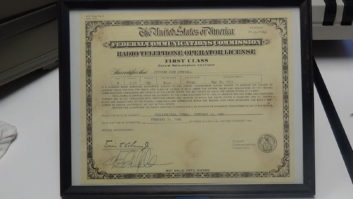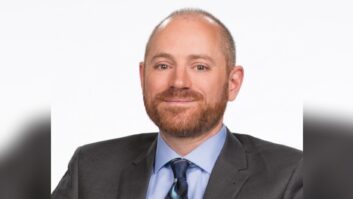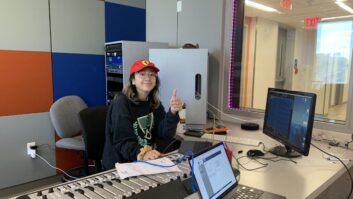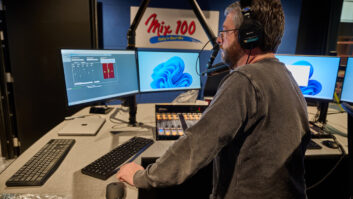Do you remember MEOV?
May 1, 2009 12:00 PM, By John Battison, P.E., technical editor, RF
Maximum Expected Operating Voltage (MEOV) is a relic of the earlier days of directional antenna design and proofing. It died about 30 years ago. I’ll cover some history since the concept formed a very important part of current antenna design work and led to the development of the standard pattern. The term also became very important in the professional life of the consulting engineer whose directional antenna system failed to operate as planned. It can also be important to today’s engineer who might encounter the term in an old proof and be puzzled by its meaning and application.

Fig. 1. Typical DA polar plot of a theoretical pattern with MEOV protection
The value of MEOV proved to be immeasurable to consulting engineers who had the foresight to use it. Some directional antenna patterns proposed to the FCC had specified zero radiation in a pattern null. The FCC’s engineers very wisely, in my opinion, eventually said it is almost impossible � and maybe impossible � to reduce radiation nulls completely to zero in view of the environment in which the antenna system has to operate. This led to development of the standard pattern, which basically imposes a built-in minimum radiation of about 6mV.
After the first excitement over the Commission’s approval of the first directional AM pattern, other engineers began to offer mathematically calculated directional AM patterns. Some of these relied solely on mathematics in presenting theoretical antenna designs. These theoretical antennas required actual construction in order to be tested and prove that the radiation field would do exactly what the design engineers said it would. Sometimes, much to the embarrassment of the designer, it was found impossible to achieve the promised radiation pattern. Occasionally large changes had to be made in the already-constructed antenna systems in order to satisfy the Commission’s requirements for licensing.
Knowing limits
The Commission’s procedure for licensing requires the antenna pattern and radiation obtained in the proof of performance measurements to always be within the limits of the proposed antenna pattern. The usual problem delaying license approval was probably the presence of unexpected measured radiation that was greater than the proposed and approved, radiation value in the pattern nulls. The solution quickly became apparent. It seems that troublesome, larger-than-acceptable, measured null values could be acceptable if they were covered in the application by an acceptable caveat.
The approved pattern was generally the theoretical pattern, if this pattern could be easily obtained. In the higher-level areas, a small deviation in the null region could probably be written into the pattern so it passed the pattern proof. In many cases it seemed impossible to get closer than plus 3 percent to 5 percent of the theoretical value shown in the application. Sometimes filing an amended Form 301 could satisfy the condition and allow licensing to proceed. Unfortunately this procedure would involve another application showing the obtainable allowable radiation, presumably more legal fees, additional delay and professional embarrassment for the consulting engineer.
The new application would show a new value in the offending null that amounted to a few percent. Some very bright person conceived the idea of filing an original application, showing the desired theoretical pattern with a broken line outside this pattern, at the potentially offending null showing the maximum expected operating value in that area.
Do you remember MEOV?
May 1, 2009 12:00 PM, By John Battison, P.E., technical editor, RF
Thus MEOV was born. It offered a wonderful means of providing a way around a potential difficulty in meeting the approved radiation pattern. So the wise thing to do whenever a directional antenna pattern was filed was to add a few percent more than the theoretical pattern in any potentially troublesome areas. As time passed it became very unusual to see a proposed DA pattern without an MEOV. As a matter of fact, several consulting engineers have been known to put an MEOV around the full 360 degrees of a pattern. Actually, this is not quite as strange as it sounds. The electronic environment surrounding directional antenna stations is still changing for the worse, and presenting more tower structures than there were 80 years ago. It was becoming more difficult every year to construct and proof a new directional when proposing a new antenna system. In much the same way as MEOV was developed, time passed and another problem involving theoretical patterns and MEOVs began to develop.
Meoving, I mean moving on
Around the end of the 1970s it became apparent that some confusion would often exist for both FCC engineers and consulting engineers; it was often difficult to determine looking through the files whether an MEOV or the theoretical pattern had been used in the final operation. To avoid this increasing confusion the Commission decided to introduce the standard pattern for directional antenna applications. The standard pattern was produced by adding a term representing the minimum allowable radiation to the generally used equation in directional antenna design. Thus was born an acceptable antenna pattern that could never decrease to zero in a null.
The Commission generated and provided a list of standard patterns for all licensed AM directional stations in the early 1980s. Later it issued the edict that all applications involving directional antennas must be based on the standard pattern. It was inevitable, of course, that there would be instances when the standard pattern just couldn’t fit due to excessive radiation on one or more azimuths. To take care of these situations, augmentation was allowed as described in the commission’s rules. Provided that the excessive radiation did not produce unallowable interference the pattern could be augmented over the pertinent arc. Appropriate information concerning the degree of augmentation used is noted in the directional antenna data. Thus any engineer can easily and accurately obtain precise information on any licensed directional station or applicant and the theoretical DA pattern with MEOV is no longer used.
E-mail Battison at[email protected].












